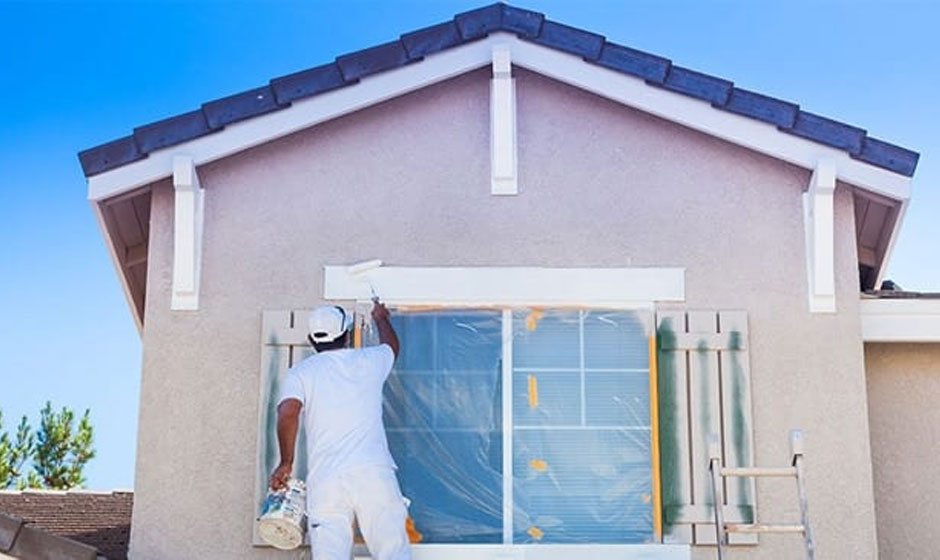Creating curb appeal and beautiful outdoor living spaces can feel daunting. While perfection may seem impossible to achieve, focusing on a few key areas and simple strategies can transform your home’s exterior into an inviting oasis. With the right products, tools, and techniques, you’ll be surprised by how attainable painting perfection truly is.
In this guide, we’ll cover essential prep work, selecting the perfect paint colors and finishes, simple techniques for flawless results, and final touches that make your space truly shine.
Exterior Painting Cheat Sheet
Before you dip your brush into a fresh can of paint, it’s crucial to understand that successful exterior painting projects rely on thorough preparation and the right approach. This guide is designed to demystify the process, offering you practical tips and tricks to achieve a professional-looking finish that not only boosts your home’s curb appeal but also provides lasting protection against weather elements. Follow these steps to ensure your painting project goes smoothly.
Begin with a Clean Slate
Start by thoroughly cleaning your home’s exterior. Use a pressure washer or a stiff-bristled brush and soapy water to remove dirt, grime, and peeling paint. This step is critical for ensuring the new coat of paint adheres properly.
Select the Right Paint and Tools
Investing in high-quality paint and the right tools can make a significant difference in the outcome of your project. Choose weather-resistant paints designed for exterior use and brushes or rollers that best fit the texture of your home’s exterior.
Tackle Repairs and Prep Work
Inspect your home for any damages, such as cracks, wood rot, or rust on metal surfaces. Repair these issues before painting to achieve a seamless finish. Mask windows, doors, and other areas not to be painted with painter’s tape.
Understand the Best Conditions for Painting
Timing is key when it comes to exterior painting. Aim for mild weather conditions, avoiding extreme temperatures or humidity, to ensure the paint dries evenly and adheres well.
Add Finishing Touches
Once the primary painting is complete, remove the painter’s tape and touch up any missed spots or edges. Adding a few strategic finishing touches, like updating door hardware or adding potted plants, can further enhance your home’s charm and appeal.
Maintain Your Masterpiece
After completing your painting project, maintaining the quality of your work is crucial for prolonged beauty and protection. Regularly inspect your home’s exterior for chips, cracks, or other damages. Address these issues promptly with touch-up paint to prevent further deterioration. Additionally, clean the exterior surfaces gently with a soft brush and soapy water at least once a year to keep them looking fresh and vibrant.
Hire a Painting Professional
If painting your home’s exterior still seems overwhelming, consider hiring a professional painting service. A skilled painter can provide expert advice on color selection and finishes, as well as tackle any repair or prep work needed for a flawless finish. While it may require a larger investment, the results and peace of mind are well worth it. Contact an exterior painting expert in Hill Country to learn more.
Best Painting Techniques for Improved Curb Appeal
Mastering the proper painting techniques is essential for enhancing your home’s curb appeal. The choice of technique can significantly affect the finish, durability, and overall appearance of your painting project. This section will introduce some of the most effective techniques to help you achieve smooth, long-lasting, and aesthetically pleasing results. Whether you’re a beginner or looking to refine your skills, these techniques will empower you to tackle your exterior painting project confidently.
Use the Right Brush Strokes
Selecting the right brush and employing the correct strokes are foundational to a professional-looking finish. For large, flat surfaces, use a broad brush or roller. Start from the top to prevent drips, and work your way down in smooth, consistent strokes. Switch to a smaller brush for detailed work or tight spaces, applying gentle, even pressure paint.
Employ the ‘Wet Edge’ Technique
To avoid lap marks, maintain a “wet edge” by overlapping each stroke with the next before the paint begins to dry. This technique is essential in warmer weather when the paint dries more quickly—work in manageable sections, planning your path to ensure that you always move towards the unpainted area.
Practice Proper Rolling Methods
When using a roller, fill it evenly with paint and remove excess to avoid drips. Apply the paint in an “N” or “W” pattern, then fill in the pattern without lifting the roller, applying even pressure throughout. This method ensures comprehensive coverage and a uniform texture.
Experiment with Faux Finishing Techniques
Faux finishing can add character and depth to your exterior walls. Techniques such as sponging, rag-rolling, or color washing can create unique textures or mimic the appearance of different materials. While these methods require a bit of practice, they can provide a distinctive and customized look.
Utilize Taping for Clean Edges
Using painter’s tape can ensure sharp, clean lines that contribute to a meticulous finish for edges, corners, and trim. Make sure the tape is smoothly applied and firmly pressed down to prevent paint from seeping underneath. After painting, remove the tape while the paint is still slightly damp to avoid peeling off any paint with the tape.
Implement the Back-Brushing Technique
Back-brushing is a technique that involves painting with a roller and then using a brush to spread and work the paint onto the surface. This method is especially effective on textured surfaces like stucco or brick, as it ensures the paint reaches into crevices for more uniform coverage and a longer-lasting finish. Work in sections, rolling on paint and following up with brush strokes while the paint is still wet.
FAQ
Q: How often should I repaint the exterior of my home?
A: The frequency of repainting depends on various factors such as climate, quality of paint used, and condition of your home’s exterior. Generally, it is recommended to repaint every 5-10 years.
Q: Can I paint over old paint?
A: Yes, you can paint over old paint as long as it is in good condition and properly prepared. However, if the existing paint is chipping or peeling, it should be removed before applying a new coat.
Q: Is primer necessary for exterior painting?
A: Primer helps to create a smooth base for the paint to adhere to, improves coverage, and enhances durability. It is highly recommended to use a high-quality primer before painting your home’s exterior.
Q: Can I paint vinyl siding?
A: Yes, you can paint vinyl siding using an acrylic paint specifically designed for plastic. Proper cleaning and priming are crucial for adhesion and achieving a long-lasting finish on vinyl surfaces.
Q: How do I choose the right color for my home’s exterior?
A: Consider factors such as the style of your home, surrounding environment, and personal preference when choosing a color. It is also helpful to test paint samples on small areas of your home’s exterior to get a better idea of how the color will look in different lighting conditions. Consult with a professional painter for expert advice on color selection.
Closing Thoughts
Proper preparation and technique are essential for achieving a beautiful and long-lasting finish when painting your home’s exterior. Whether you tackle the project yourself or hire a professional, investing in high-quality materials and utilizing effective techniques can make all the difference. With these tips in mind, you can enhance your home’s curb appeal and enjoy a fresh, vibrant look.






